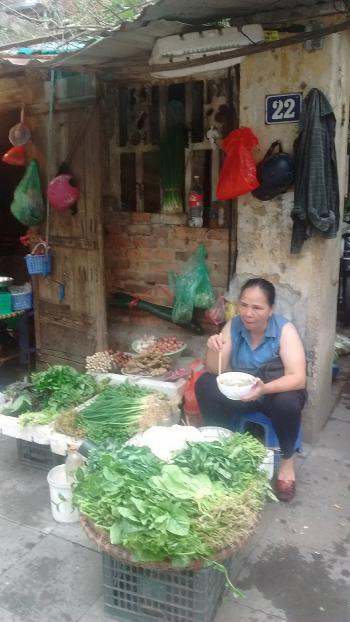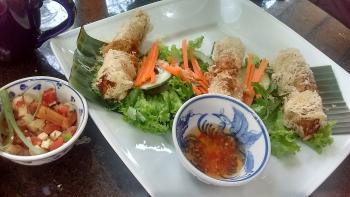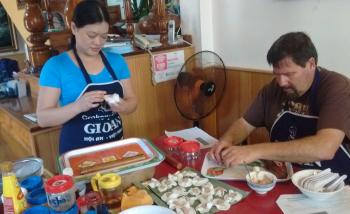Epicurean escapades in Vietnam
This article appears on page 36 of the October 2018 issue.
There are people who merely like to cook, and then there are people who lay awake at night devising an entire menu for their next dinner party. I am one of the latter.
When you are obsessed with food, it plays a critical role in many facets of your life, including in deciding where to travel. In researching various destinations for a spring 2018 trip, I came across a passage that read, "Vietnam is the culinary capital of Southeast Asia (sorry, Thailand)." I was sold.
My husband and I and two friends of ours booked a 6-day tour for the end of April through Gate 1 Travel (Fort Washington, PA; 800/682-3333, gate1travel.com) and planned to extend our stay. It was then that my scheme was hatched!
I discovered that each region of Vietnam has its specialties, and I wanted to try them all… or at least as many as I could fit in. Traveling with three other people made that easier, as we all liked to share.
Starting in Saigon
We flew to Saigon (Ho Chi Minh City) and found that the food there is influenced by the city's location, near the Mekong Delta. A lot of fish sauce and tropical fruit are used, and many tables included a very tasty simple sauce made with salt, pepper and a generous squeeze of one of the little limes that were the size of marbles (although I'm sure regular limes would work).
On our first night, we stumbled upon Spice Bistro (2, Thi Sách), situated in a large, palm-thatched patio with a menu to delight the adventurous eater. My favorite dish was fried chicken served in a pandan-leaf wrapper. From what I can tell, this dish is actually from Thailand, but if you first have it in Vietnam, then I say it counts.
I removed the leaf wrapper and popped a bite-sized piece of chicken into my mouth, biting through the crisp outer layer of caramelized soy and coriander subtly infused with pandan flavor and into a moist chunk of chicken. So good!
Unfortunately, I don't think pandan leaves are easily found in the US, so this recipe would be hard to replicate.
The next day we were walking the hot streets looking for a place with AC for lunch. We found RuNam Bistro (2-4-6 Dong Khoi) on the street along the waterfront. One member of our party ordered bôt chiên RuNam, a large, crispy egg pancake topped with grilled octopus and served with soy and chili sauce. With the crispiness of the pancake, the toothsome octopus and the play of sauces across the palate, I definitely had entrée envy.
Later that night we decided to investigate Saigon's beer culture. Bia hoi (draft beer) stands abounded and prices were cheap, but they served typical, bland beer. The good news is that there are also craft beer places that serve up some excellent brews. Heart of Darkness Brewery (31D Lý Tu Tro·ng; heartofdarknessbrewery.com) was my favorite.
Loose Rivet, a New England-style hazy IPA, was excellent, with 7.5% ABV (alcohol by volume) and 59 IBUs (International Bitterness Units). For hopheads, try Kurtz's Insane IPA, with 7.1% ABV and a whopping 102 IBUs.
Next, we headed to Pasteur Street Brewing Co. (144 Pasteur St.; pasteurstreet.com) to their "rooftop" bar, where we were surrounded by tall buildings and looked down into a courtyard covered by a mishmash of corrugated rooftops. The brewers there were very creative, however, offering a dragon-fruit Gose (sour beer) and a watermelon IPA that was refreshing and slightly fruity, balanced and not overly hoppy.
Hot in Hanoi
The northern capital of Hanoi was our next stop, and the style of food there was much milder and used a lot less spice. A few blocks from our hotel was an extremely casual eatery famous for its bún cha (rice noodles and pork). President Obama had eaten there, and the restaurant featured an Obama Special (about $6), including bún cha, spring rolls and a beer.
The restaurant was hot, despite the electric fans furiously blowing napkins and empty bottles off the tables, and service was not very tourist-friendly, as our small group was served after several other parties who came in after us. The bún cha had thin slices of grilled pork and spiced pork patties in a bowl of noodles and broth. Alongside came a pile of lettuce and mixed herbs, including shiso leaf, cilantro and what I think was Vietnamese mint.
Another famous dish from Hanoi is cha cá, turmeric fish with dill. The restaurant that made this dish famous, Cha Ca La Vong (14 Pho Cha Ca), had just published their recipe in the in-flight magazine for Vietnam Airlines. I have made this dish at home and can attest to its deliciousness. I use US farm-raised catfish, which has a mild flavor and is sustainable.
Hoi An highlights
After Hanoi, we headed to the City of Lanterns, the beautiful, historic Hoi An. Hoi An is an area with a fortunate culinary history. Being a major trading port for over 500 years, the architecture and the food are influenced by the Chinese, Japanese and Cham people. The ancient royal city of Hue, nearby, added elegance and refinement to the culinary melting pot.
Emperor Tu Duc had a reputation for being finicky, and he is attributed with inspiring some of the more sublime creations for which the area is famous.
Our first dinner was at Morning Glory (106 Nguyen Thai Hoc St.), where we were served the eponymous morning glory as a stir-fried green, similar to spinach, and another memorable dish, a subtly spiced shrimp paté grilled on sugarcane skewers.
During the day, we decided to visit the historic buildings of Hoi An for which we bought a pass. Once past the ticket booth, located just beyond the large model of an ancient sailing ship, there was a bánh mì (pork sandwich) stand on the right. I just couldn't resist, so I ordered one — for a dollar — and it was the best bánh mì of the trip!
The baguette was toasted slightly over a charcoal grill, split down the middle and ladled with garlic oil and a slather of chili sauce, then slabs of pork paté, grilled pork and pork floss were stuffed into the bread. A handful of lettuce, cilantro and rau ra˘m (Vietnamese coriander) topped it off. Perfect!
Later, at the restaurant Mango Mango (45 Nguyen Phúc Chu), we had a delicious fish-cake appetizer. Peekin' Duckling — a sliced, boneless duck breast with Peking duck spices — was the entrée hit of the evening. The giant prawns we ordered were large, with a tasty, sweet, tomato-garlic sauce, but they were flabby and lacked flavor.
The grandma rolls at Mai Fish (45 Nguyen Thi Minh Khai) were an interesting take on spring rolls, with a unique, shredded, crispy wrapper encasing pork, taro, shrimp and herbs.
We ate at several street-food places, and it is safe to say that in Hoi An, the street food is as good as that in restaurants… or maybe better if you snag a seat on the riverside and watch the glowing lantern boats gliding up and down the river. The drawbacks are the more limited menus and no beer or alcohol.
Throughout this trip, the meals we had on this trip averaged $20 per person, including appetizer and entrée.
In the classroom
Because of this cuisine's complexity, I decided to enroll myself and my husband in a cooking class while in Vietnam. I found many options, most offering set menus and some that even do the prep work before you arrive.
Weighing the many options, including all-day tours by boat (Hoi An Eco Cooking Tour) or bicycle (Grasshopper Adventures), classes on farms out in the country to cook "grandma food," tours at an herb farm (Red Bridge), where you pick greens to cook, and classes by famous Hoi An chefs (Vy's Market) aimed at different skill levels, I opted for Gioan Cooking School (222/17 Ly Thuong Kiet St.; gioancookery.com).
This place had a menu of about 50 items you could choose from to cook. The class length was 2½-3 hours, and a variety of start times was offered.
I liked that the school was in town, they picked us up from the hotel, and the class included a trip to the local market to pick out our food. (The cost was $40 per person with a minimum of two people; the single cost was $70.) The market tour with the bubbly, enthusiastic Vina was a kick.
The open-air market was very authentic. We were the only tourists there, and I have to advise that this is not a place for the squeamish.
Vina explained the health benefits of many of the foods, and we got to sample several varieties of tropical fruits.
The very capable Hanh showed us how to make the three items we selected: banana-flower salad, white rose (special steamed dumplings) and caramelized pork in a clay pot. Hanh showed us up with her fine knife skills, all the while chatting away and making us feel at home. We received a booklet with our recipes, and they offered a cookbook for sale with all of their recipes.
I especially appreciated making the dumplings, as I now know how to shape the dough and how it's supposed to look and feel when it has been kneaded enough. I was proud the next day when we sampled white rose dumplings at a restaurant and agreed that my dough was more tender.
When I travel, I don't buy many souvenirs, but if you visit my blog (potluckclubrecipes.wordpress.com/category/viet-nam-scrapbook), you'll find the recipes I collected on this trip for my culinary scrapbook. The unique flavors will always bring back memories of the friendly people, beautiful countryside and culinary adventures of my trip to Vietnam.



